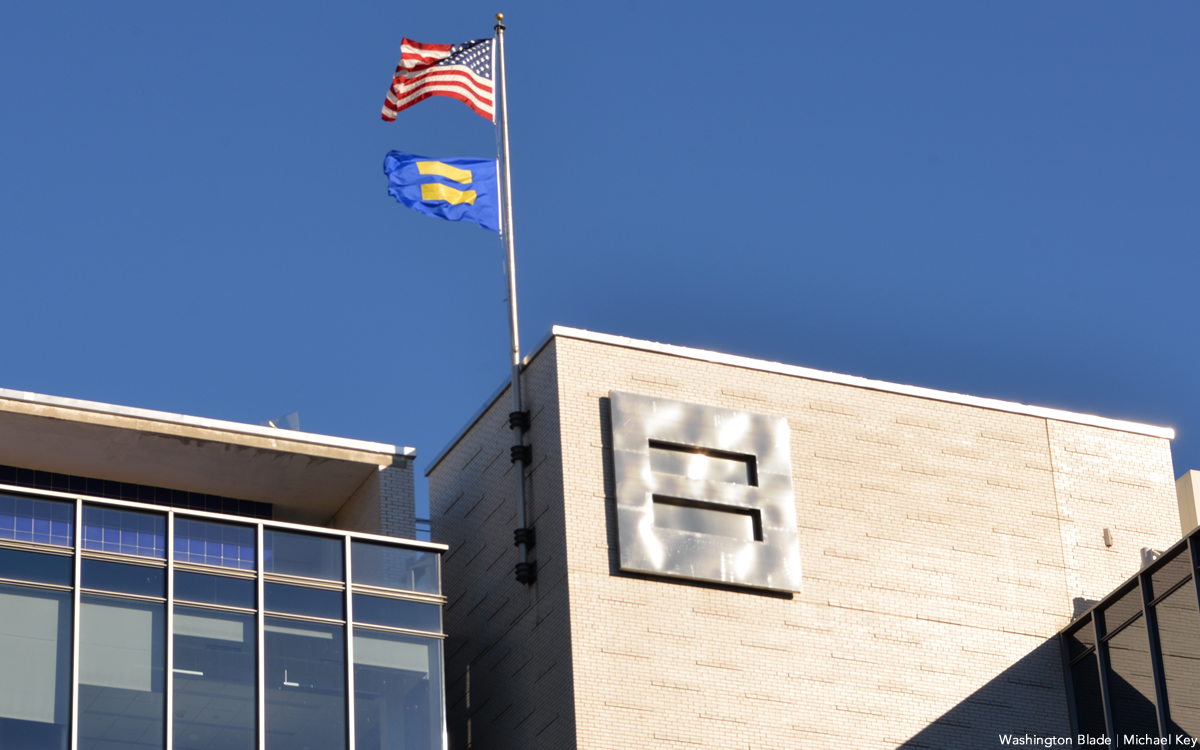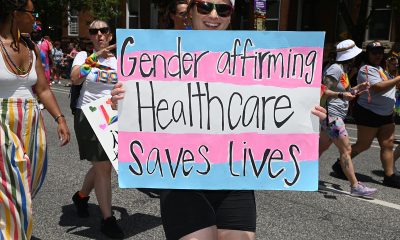LGBTQ Non-Profit Organizations
Anti-trans healthcare bans have ‘striking’ impacts on LGBTQ adults, HRC report finds
Study spotlights impacts of Florida Gov. DeSantis’s anti-LGBTQ policies

According to findings from the Human Rights Campaign Foundation’s 17th Annual LGBTQ+ Community Survey, the proliferation of bans on gender affirming care in conservative states have had “striking” impacts on “the health and well-being of LGBTQ+ adults.”
For example, 79.1 percent of respondents reported feeling less safe as an LGBTQ person as a result of these health care restrictions, while nearly half said the policies affected the physical and/or mental health of themselves or their loved ones.
Some of the specific negative consequences of gender affirming care bans, 80.5 percent of respondents said, include the worsening of “harmful stereotypes, discrimination, hate, and stigma against the LGBTQ+ community.”
HRC conducted the survey, which included more than 14,000 LGBTQ adult participants from all 50 states and D.C., in partnership with Community Marketing and Insights, publishing the findings in a report released on Thursday.
The group noted more than 80 anti-LGBTQ bills were passed in statehouses across the country so far in 2023, including bans on guideline directed gender affirming health care that are now enforced in 19 states — which, collectively, are home to a third of all trans youth in the U.S.
Along with addressing the survey questions, participants submitted written responses that provide more information and context about the ways in which their lives have been impacted by the anti-trans legislation.
For example, the survey’s finding that more than half of transgender and non-binary adults nationwide “would move — or already have moved — from a state that passed or enacted a gender-affirming care ban” is preceded by a quote from a trans/nonbinary man about the emotional decision of having to flee his home state:
“My home state, where I no longer live, is one of the states most affected by the wave of
legislation,” he said. “My community there is in so much pain, and it pains me very much that I may never be able to visit home again.”
Anti-trans policies have profoundly shaped how LGBTQ adults organize their lives, the data shows, influencing decisions about where they live, work, go to school, and spend their money.
HRC’s report includes a section on Florida, noting it had issued a travel advisory on the risks of visiting or relocating to the state as a result of the “extremely anti-LGBTQ+ agenda” pushed by its Republican Gov. Ron DeSantis, who, by running for president, “has threatened to bring his discriminatory policymaking to the national level.”
“I feel like I am losing my basic rights over my body and my right to exist in public spaces,” wrote a transmasculine/nonbinary Floridian. “I feel dehumanized.”
LGBTQ Non-Profit Organizations
Evan Low named next LGBTQ+ Victory Fund president
Former Calif. lawmaker to succeed Annise Parker

The LGBTQ+ Victory Fund and LGBTQ+ Victory Institute have named gay former California state Rep. Evan Low to serve as its next president and CEO, the groups announced on Tuesday.
“Today, we face an existential crisis,” he said. “The LGBTQ+ community, along with other historically excluded communities, are being systematically legislated out of existence.”
He added, “I am committed to ensuring our voices are not just included, but impossible to ignore—and represented at the highest levels of office.”
Low will succeed former Houston Mayor Annise Parker, who announced in February 2024 that she would step down after leading the organizations since 2017.
The Victory Fund works to increase the number of LGBTQ elected officials serving in all levels of government and “has helped thousands of LGBTQ+ candidates win local, state, and federal elections.” The Victory Institute works to ensure “the success of our LGBTQ+ elected and appointed officials at all levels of government.”
Before his election to the California State Assembly, where he served from 2014-2024, Low was the first Asian American to serve on the Campbell City Council, going on to lead the city as the country’s youngest openly LGBTQ mayor.
In the state legislature, Low “led groundbreaking efforts in marriage equality, LGBTQ+ rights, and economic opportunity,” the Victory Fund said in a press release.
“His leadership and service have been widely recognized, earning him multiple ‘Legislator of the Year’ honors and a proclamation of ‘Evan Low Day’ from then-San Francisco Mayor Gavin Newsom.”
LGBTQ Non-Profit Organizations
Blade to cover Creating Change conference in Las Vegas
National LGBTQ Task Force convenes movement leaders at a pivotal moment

The Washington Blade will be in Las Vegas this week to cover the National LGBTQ Task Force’s flagship annual Creating Change conference, Jan. 21-26, where movement leaders will convene at a pivotal moment for LGBTQ rights.
More than 3,000 are registered to attend, nearly a third of whom identify as transgender or gender nonconforming, and more than half as people of color. A livestream of the plenary sessions is available here.
This year’s conference comes days after the inauguration of President Donald Trump, along with his administration’s issuance of executive orders targeting immigration and LGBTQ rights, together with the revocation of his predecessor’s executive actions that established and clarified rights and protections for these and other marginalized communities.
For instance, Trump on Monday signed an order to direct the federal government to recognize only two genders, based on birth sex, which will likely mean that U.S. citizens will no longer be able to select the “X” gender marker for their passports and official documents, though the U.S. State Department has not provided clarity on how that will be enforced.
In recognition of the shifting legal and regulatory landscape — and the need for immigrant and trans or gender nonconforming communities to understand and prepare for changes in the coming weeks and months — the Task Force this year has organized sessions like “Protecting Your Rights: Navigating Legal Systems” with attorneys from the Transgender Law Center, the National Center for Lesbian Rights, and Oasis Legal Services.
Along with covering breaking news from sessions during the four-day program, the Blade will be talking with experts for stories focused on the backlash against diversity, equity, and inclusion initiatives, the Trump administration’s expected ban on military service by trans people, insights into how major LGBTQ advocacy organizations are preparing to push back against actions by this White House and congressional Republicans, and more.
LGBTQ Non-Profit Organizations
Gov. Tim Walz to headline HRC National Dinner
Tickets still available for event on Saturday

Minnesota governor and Democratic vice presidential nominee Tim Walz will be the keynote speaker at the Human Rights Campaign National Dinner on Saturday, the organization announced on X.
BIG NEWS: We are thrilled to have Vice Presidential Nominee Governor Tim Walz join us at our National Dinner! He has been a steadfast champion for the LGBTQ+ community and will continue fighting for our rights once he is elected to the White House. pic.twitter.com/nRsZfzuMYg
— HRC 🥥🌴 (@HRC) September 4, 2024
Tickets are still available for the event. HRC is also hosting an Equality Convention this week, “a destination for trailblazers in politics, culture, and business who are igniting change and driving LGBTQ+ equality forward.”
When Vice President Kamala Harris, the Democratic 2024 presidential nominee, announced Walz as her running mate on Aug. 6, HRC President Kelley Robinson said her pick “sends a message that a Harris-Walz Administration will be committed to advancing equality and justice for all.”
The group wrote in a press release: “Governor Walz is a career-long champion for LGBTQ+ people. In 1999, as a history teacher and football coach, Walz sponsored the school’s first gay straight alliance student group.
“He opposed efforts to ban same-sex marriage in the Minnesota Constitution. While serving in Congress, he co-sponsored legislation to repeal the Defense of Marriage Act (DOMA), voted to repeal the discriminatory ‘Don’t Ask, Don’t Tell’ law, voted for the Matthew Shepard/James Byrd Jr. Hate Crimes Prevention Act and introduced legislation to protect LGBTQ+ service members from discrimination in benefits.
“As Governor, Tim Walz signed an Executive Order banning the dangerous practice of ‘conversion therapy’ in Minnesota.”
HRC in May pledged $15 million to organize in key battleground states for the Democratic ticket. Just days after President Joe Biden stepped out of the race and backed Harris as the presumptive nominee, the group raised more than $300,000 for her campaign in a virtual fundraiser.
-

 Virginia2 days ago
Virginia2 days agoDefying trends, new LGBTQ center opens in rural Winchester, Va.
-

 South Africa4 days ago
South Africa4 days agoLesbian feminist becomes South African MP
-

 Travel3 days ago
Travel3 days agoManchester is vibrant tapestry of culture, history, and Pride
-

 Opinions3 days ago
Opinions3 days agoUSAID’s demise: America’s global betrayal of trust with LGBTQ people












